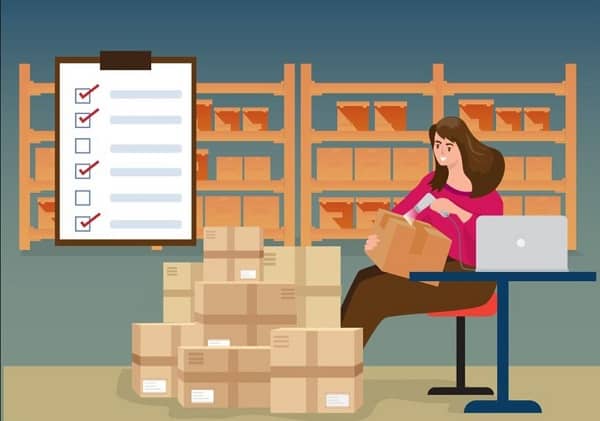Part of running an ecommerce business is making sure you have enough inventory. Whether you have the inventory on hand, in a warehouse, or have a dropshipping model, inventory management ensures smooth selling operations and avoids unhappy customers.
Plenty of inventory management problems can affect your online business and profit. That’s why it’s important to know the most common issues and the best solutions for them.
Why proper inventory management is important in ecommerce
Picture this: you’ve made a purchase online and are waiting for the seller to pack and ship your order. However, a few days after purchasing, the seller hasn’t progressed with your order.
You finally message the seller asking about your order, only to find out that they don’t have it in stock. You now have to choose between waiting for them to restock, or canceling and having to find another seller.
If this feels like such a hassle and inconvenience, imagine what your actual customers would feel. When your customers aren’t happy, they’re more likely to find other sellers. And forget about them ordering from you again!
Overstocking nightmare
On the opposite end, inventory management also prevents you from overstocking. You might have heard horror stories of sellers who overstocked items that were going viral, such as loom bands, fidget spinners, and the more recent lato-lato.

They thought plenty of people were going to purchase them. But once the hype died down, they were left with inventory that wasn’t selling.
Proper management of your inventory prevents incidents that hassle your customers, creates a better experience, and protects your business from financial losses.
Also read: Inventory Management Techniques for Online Sellers
7 common inventory management problems
These are some of the most common inventory management problems and mistakes online sellers make.
1. Warehouse management inefficiency
Whether you manage your own inventory or work with a warehouse to handle storage and fulfillment, it becomes a problem when you have inefficient processes that cause delays and order mistakes.
This can lead to longer delivery times for your customers or not getting accurate real-time data about your stock.

2. Inaccurate data and inconsistent tracking
This happens when the information about your inventory isn’t reliable or not consistently updated. For example, if you’re down to five units of a certain product, you should have a way to know that and then reflect it on your online store.
If a customer wants to buy 10 units and your shop isn’t updated, this can lead to problems with fulfillment and customer satisfaction.
3. Changing demand and poor forecasting
As much as possible, your inventory management should be based on purchasing data. If you buy too much or too little inventory, it can result in financial losses.
Online business owners should be able to tell how much or how little inventory they need depending on demand and their own data.
4. International supply chain complexity
This refers to the challenges that arise because of the global supply chain. Unless you’re working with a reliable logistics partner with international reach, you need to account for unpredictable lead times, customs, and how reliable your international manufacturers and distributors are.
#NinjaTip: Ninja Direct is your one-stop shop for all your sourcing and procurement needs — find quality suppliers, enjoy flexible payment, and get seamless cross-border fulfillment. Learn about Ninja Direct today!
5. Increasing competition
How unique are your products? With more online businesses offering similar products, you need to manage your inventory to deal with the added competition.
This means having to consider your prices and finding ways to differentiate your products. Additionally, depending on your market share, competition can affect how much more or less inventory you need to purchase.
6. Obsolete inventory or inventory loss
These occur when your products are outdated or unsellable due to issues like poor storage that result in damage or the product’s expiration date.
Buying too much inventory and not selling enough can result in financial losses.

which will affect your ROI.
7. Poor communication and management
Poor communication and management with your team or fulfillment service provider can lead to confusion, lack of coordination and inefficient operations. This could lead to making wrong decisions, such as buying more inventory when you actually still have enough.
Steps to avoid problems in inventory management
1. Analyze your data
Sellers can minimize inventory management problems by analyzing sales data to identify trends and changes in the demand, and then adjust their inventory accordingly.
Many ecommerce platforms offer tools to track data, but investing in additional software can help with making accurate predictions. This allows sellers to make informed decisions and reduce the risk of stockouts or overstock situations.
2. Avoid overstocking
Use historical data to determine how well your product sells, and then adjust your reorders accordingly. While it might seem like a good idea to have more than enough stock, you have to account for trends, demand and your ROI.
It’s much better to reorder as needed than to end up with a financial loss because you can’t sell your remaining inventory.

3. Automate reordering
Many modern inventory management software allow sellers to automate the reordering process when their inventory reaches a certain quantity. This reduces the risk of both stockouts and overstocking while streamlining the supply chain and improving overall efficiency.
4. Compare 3PL service providers
When it comes to inventory management, not all third-party logistics service providers offer the same level of accuracy, efficiency and reliability. Given that factors like fulfillment and inventory management are crucial to customer satisfaction, choosing the right service provider can be beneficial to your bottom line.
5. Real-time tracking solutions
Real-time tracking solutions allow you to check stock levels, order fulfillment, and supply chain movement in real time. Not only does this provide you with an overview of your inventory, but it also allows you to make the necessary decisions to prevent selling out or overstocking.
Why outsource your inventory management to Ninja Van
Ninja Van understands the importance of streamlined operations, which is why we offer inventory management solutions as part of our fulfillment and warehousing services.

manage your inventory and fulfillment.
Top reasons to choose Ninja Van:
- Real-time inventory management: You get real-time data of your inventory and live update or your orders’ status. Our standard warehouse management services give you a general oversight of the entire fulfillment process so you can always keep track of your inventory.
- Streamlined fulfillment operations: Get a cost-effective solution for storage and fulfillment. We can receive your inventory directly from your supplier and update your inventory. Our team will conduct basic quality control and do the picking, packing and shipping on your behalf.
- Easy integration with your platform: Whether you’re selling on Lazada, Shopee, TikTok, or your own online store on Shopify, our software offers seamless integration. This means that we receive orders automatically, allowing our team to start the fulfillment process as soon as possible.
And with Ninja Van’s reach expanding to the rest of Southeast Asia, the opportunities to assist you with inventory management and order fulfillment go beyond our local warehouses.

Learn more about our Fulfillment and Warehousing solution today!
Or get in touch with us at ph-niu-fulfillment@ninjavan.co to get a quote on your customized solutions.
More tips to optimize your inventory and fulfillment:
The 6 Steps of the Order Fulfillment Process
Signs You Need to Outsource Your Order Fulfillment
Shipping from China to the Philippines: An Easy Guide






